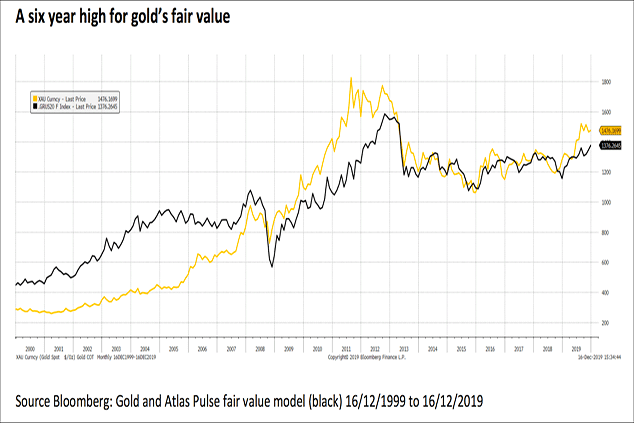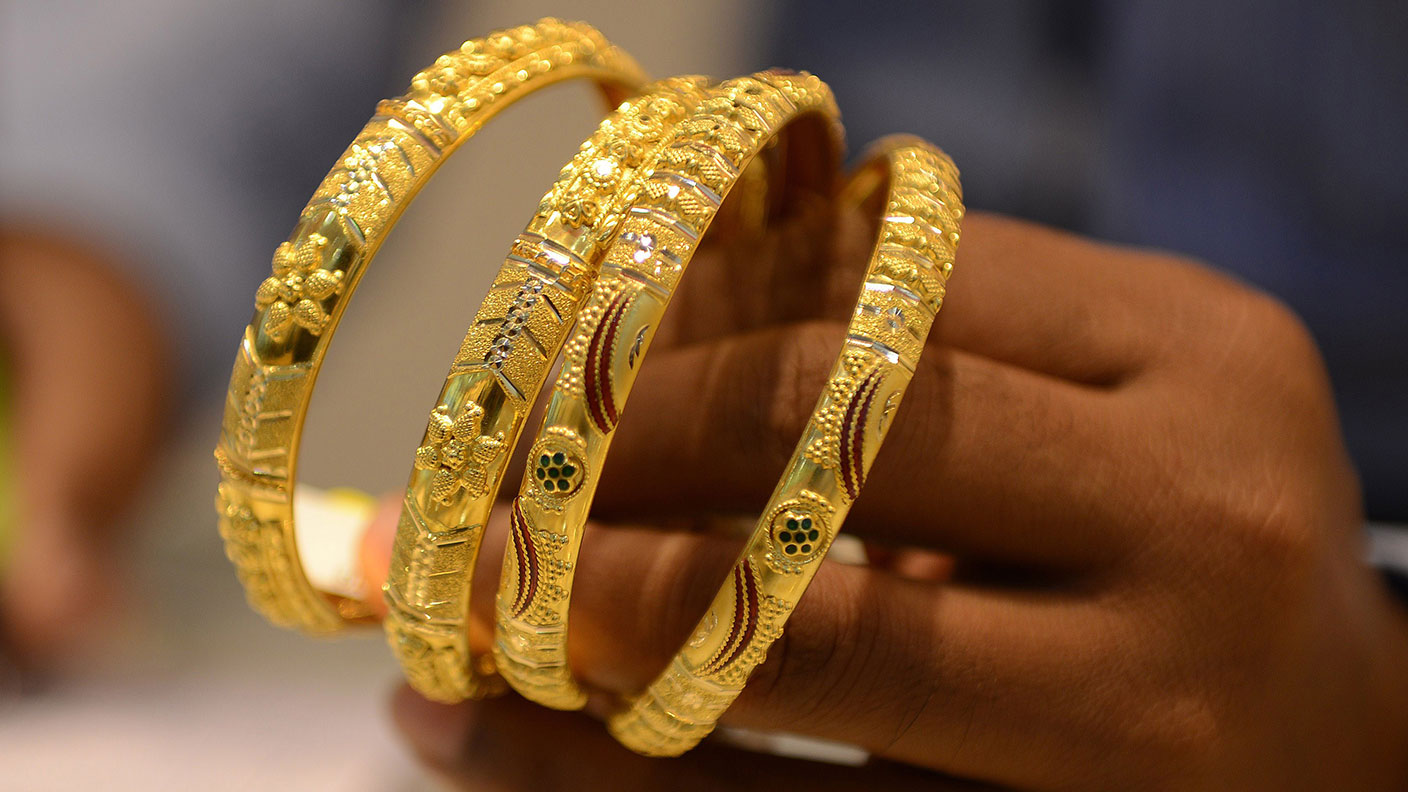Here’s how gold could rise above $7,000 an ounce
That the gold price could hit $7,000 an ounce is a logical and plausible possibility, says Charlie Morris. Here, he explains how it could get there.

On Friday, I reiterated that gold is in a bull market, and I suggested that a bullish target for $7,166 is both logical and plausible.
So how did I reach that conclusion?
Allow me to talk you through it, step by step below.
MoneyWeek
Subscribe to MoneyWeek today and get your first six magazine issues absolutely FREE

Sign up to Money Morning
Don't miss the latest investment and personal finances news, market analysis, plus money-saving tips with our free twice-daily newsletter
Don't miss the latest investment and personal finances news, market analysis, plus money-saving tips with our free twice-daily newsletter
How inflation could get going again
US real interest rates are falling again.
The real yield is the difference between the US government bond yield and the expected future inflation rate. It tells you how much you could make, after inflation, by investing in government bonds. The current rate is 0.1%. That doesn't sound like much but is much better than what you'd get in Europe.
This means that gold has a tail wind. And in my opinion, real rates will keep on falling in what could become a major theme for the decade.
I am not saying that the Federal Reserve will slash rates to zero like the Europeans. But rates will stay lower for longer, and inflation will rise. We can be relatively sure that the Fed will keep rates low, because they want to keep the party going.
We saw that a year ago, as the ten-year bond yield went above 3%. The result? The stockmarket nosedived by 20%. They don't want to see that repeated.
The missing piece is inflation. Many believe that it won't rise, because high levels of debt or demographic trends will keep it under control. But there's an external risk namely the price of oil.
Energy is the most important input cost in our lives. For example, food production requires diesel. If the oil price rises, food prices must follow suit. That squeezes the consumer, harms the economy and reduces purchasing power. And even if the green revolution surprises us all, it will take years before it becomes a dominant force.
In the meantime, Asia keeps on growing. According to the OECD, not only is China forecast to fly past the almighty US by 2030, but India too. The US could be humiliated into third place.
President Donald Trump doesn't like that idea and hence a new cold war with China is underway. Europe might be even more embarrassed, as it may not have a single country in the top five. Indonesia, a nation of 300 million people by 2030, might squeeze past Germany. With Japan's place relatively secure, an Asian decade seems increasingly likely.
On that point, while energy consumption has remained flat in the OECD countries, the fast-growing non-OECD countries have seen their consumption nearly double this century. It grows by 3.3% per year and shows no signs of slowing down.
The US shale boom came to the rescue post-2006, bringing another six million barrels per day (mbpd) to market. That has kept a lid on the oil price since 2014, but if the non-OECD countries carry on at this pace, a future oil shock becomes more probable than possible. Consider that the OECD countries are growing too, and you can see how this Malthusian story might play out.
And let's not forget the growing US budget deficit (annual government overspending). Nor are deficits unique to the US, indeed they are coming back into fashion. Japan has a stimulus package; the UK has one; Europe wants one. China will join the party too, and the world wants infrastructure like it's the industrial revolution all over again. Demand for commodities will soar. The new gold bull market is simply telling you what lies ahead.
Laying the foundations for the epic gold bull market of the 2020s
As we approach 2020, it's worth considering where gold might be by 2030. The 00s saw a 280% increase, and the 10s, a 35% increase. For the 2020s, I am forecasting a 415% return with a price target of $7,166. I'll explain why.
The Atlas Pulse fair value model (see chart below) treats gold as a 20-year, zero coupon, inflation-linked bond. Thus falling real rates are bullish and rising real rates are bearish, with historic inflation acting as the long-term tailwind.

Note that the fair value has made a six-year high; recovering the lost ground since the taper tantrum. Also note that gold has returned to a premium above fair value. With those points in mind, my bullish scenario has three components:
1. Falling real yields will boost the fair value to $3,3862. The premium (to fair value) will grow to 50% from the current 7%3. Actual inflation for the decade is 48%
The US long-dated real yield fell from 4.3% to 1.4% over the 2000s. That boosted the fair value of gold by 80%. The 2010s saw further easing of real yields to 0.1%, which boosted gold by a further 15%. These don't seem like big numbers and they aren't. That's because real yields are made up of the bond yield and expected inflation, but these two components are not equal in their contribution.
This important point is that the gold rally of the 21st century has had nothing to do with inflation it's been all about the falling bond yield. By my calculations, falling nominal yields have boosted gold by around 270%. On the other hand, weak inflation has actually held gold back, albeit slightly.
I hope this becomes clear on the table below showing future fair value scenarios. The US 20-year bond yield is currently at 2.08% and 20-year inflation expectations are at 1.77%. That puts the fair value at $1,377, which is slightly below the current price, and highlighted in grey.

If the real yield was to fall to -2%, different possible scenarios are highlighted in green. Notice how a 0% bond yield with 2% inflation brings us to $2,296. In contrast, a 2% bond yield with 4% inflation gives $3,386. That's a big difference for the same real yield scenario of -2%. My 2030 scenario sees a -2% real yield driven by managed rates at 2% and inflation rising to 4%. That results in a $3,386 price target.
Can US real rates move to -2%? They can. UK real rates are currently -2.2%, Swedish are -1.7%, and -1.3% in Germany. All you'd need is a couple of rate cuts to anchor the long bond, while inflation quietly rises towards 4%. With infrastructure spending about to splurge, it's looking quite likely.
But it doesn't end there as gold bull markets also attract a premium.
A rising gold premium
We should remind ourselves that the last bull market saw the gold price premium rise between 2005 and 2011. It started at a 55% discount and ended at a 51% premium by 2011. The monthly chart hides that (shown below), but it happened.
Gold also went to a significant premium back in 1980, at the height of the bull market. It must have been at least 50%, but we'll never know because inflation expectations weren't known at the time, as TIPS hadn't been invented. Still, there was unquestionably a premium, because the animal spirits were off the record, as the history books remind us.
The gold premium tends to be a trending affair. It would be wrong to suggest that just because an asset has a fair value, it must trade there. That's not how markets work. More likely, the asset will mean-revert around fair value over the course of market cycles.
What caught my attention was the new high for fair value on the previous chart, and what looks like a rising trend on this chart. More importantly, bull markets and premiums go hand in hand. Therefore, if my bull market forecast is correct, the premium will be right too.
The current gold premium is 7%. A move to a 50% premium means there is another 43% to be had before we get there. That means the gold price will touch $3,386 x 43% = $4,842.
But it doesn't end there either. Next, we must add actual inflation. That is the inflation that actually happens, as opposed to what is expected.
Inflation doesn't matter in the short term but it really matters in the long run
In the short-term, inflation doesn't matter very much. If you are fortunate enough to live in the developed world, you don't notice rising prices week after week. But over longer time frames, inflation is an enormous force. Look at the inflation by decade in the US, as per Bloomberg's CPI figures.
1950s: 24%1960s: 28%1970s: 158%1980s: 64%1990s: 34%2000s: 28%2010s: 19%
At 19%, this past decade has seen low inflation. Perhaps that is unsurprising as we had a banking crisis. But that was 11 years ago, and low inflation won't last forever. Normally change occurs when the status quo is deeply embedded in group think.
The fiscal programmes come courtesy of a belief, by our masters, that cheap money will continue indefinitely. Those same folks thought the gold price would fall indefinitely in the late 1990s, and were heavy sellers as a result. How wrong they were then and how wrong they could be now. If inflation returns, it won't be the first time our masters got it wrong.
I don't have a crystal ball for inflation in the 2020s, but the bond market does. It thinks the answer will be 19%; precisely what it was last decade. I am 100% sure that it won't be 19%. Whether it's oil, deficits, wages or policy, inflation will rise. I would hazard a guess that it will average 4% per year, resulting in 48% over the next decade.
And that neatly brings the gold price forecast to $4,842 x 48% = $7,166.
So there you have it. A rational case for a gold bull market with a logical outcome of $7,166 by 2030. The margin for error is wide of course, but it makes sense to me.
The beauty of having a target is that it makes you think. And the beauty of having a model, is that it enables you to continuously rethink your target. I may of course revise it, come the next issue but that's what the model is for.
Charlie Morris is the head of multi-asset at Atlantic House Fund Management, and is also a regular contributor to MoneyWeek. This article was first published in the Atlas Pulse newsletter, in December 2019. Sign up for Atlas Pulse newsletters to receive them when they are released. Charlie is also CEO and founder of cryptocurrency data site, bytetree.com.
Get the latest financial news, insights and expert analysis from our award-winning MoneyWeek team, to help you understand what really matters when it comes to your finances.
-
 How cancelling unused direct debits could boost your pension by £37,000
How cancelling unused direct debits could boost your pension by £37,000A new year refresh of your spending could save you money and help boost your pension pot.
-
 NS&I cuts interest rates on 8 savings accounts
NS&I cuts interest rates on 8 savings accountsNS&I will now offer less attractive interest rates for customers wishing to lock their savings away to grow for one, two, three or five years.
-
 Metals prices wobble on slowdown fears
Metals prices wobble on slowdown fearsNews The S&P GSCI index of 24 major raw materials has fallen back 9% since mid-June on growing fears of a recession, and copper has hit a 16-month low after losing 22% since a peak in early March.
-
 How to invest in energy and metals as tech stocks crash
How to invest in energy and metals as tech stocks crashAnalysis It’s been a terrible week for stockmarkets. But not everything is crashing – “real” assets such as metals and energy are holding up well and should have a good 2022. Dominic Frisby picks the best ways to buy in.
-
Gold regains some of its shine
News The gold price perked up this week, hitting a four-week high.
-
 Gold regains its shine after inflation risks resurface
Gold regains its shine after inflation risks resurfaceAnalysis Gold prices have been rising over the past month as fears of US inflation resurface. Saloni Sardana explains whether this could usher in a new bullish era for the precious metal.
-
 The going looks good for gold
The going looks good for goldAdvice With inflation fears rising and interest rates nailed to the floor, the outlook for gold is bright, says John Stepek.
-
 Governments’ money-printing mania bodes well for base metals
Governments’ money-printing mania bodes well for base metalsTips Money is being printed like there is no tomorrow. Much of it will be used to pay for infrastructure projects – and that will be good for metals, says Dominic Frisby.
-
 Mark Mobius: “I love gold”
Mark Mobius: “I love gold”Features Mark Mobius, perhaps the best-known emerging markets investor in the world, reckons that gold should form at least 10% of any investor’s portfolio. And now is a good time to buy.
-
 Gold is poised for a new bull market
Gold is poised for a new bull marketFeatures The price of golf has hit a six-year high, breaching the $1,400 an ounce level not seen since August 2013.
